What is Employee Engagement? [+11 Data-Backed Benefits and Strategies]
[ad_1]
If you’re playing along with buzzword bingo, you’ve heard the term “employee engagement.” But it would be a mistake to dismiss it as just a buzzword. Ignoring engagement costs the global economy 8.1 trillion dollars each year, according to a study by Gallup.
Thankfully, the opposite is also true. Improving employee engagement can boost profitability, improve customer satisfaction, and even make for a safer workplace.
Read on to learn what employee engagement is and what factors affect it. Then discover 11 strategies for improving employee engagement at your workplace.
What is employee engagement?
Employee engagement is the measure of a person’s commitment, involvement, and enthusiasm for their job and workplace. An engaged employee knows how they fit into the company’s plans, and works toward achieving company goals. Put simply, it’s the difference between showing up for work and showing up for a paycheck.
Engagement means that employees:
- Know what they contribute toward their team’s success.
- Work toward their company’s goals and values.
- Are connected to and supported in their role.
- Look for ways to learn and grow in their role.
Employee engagement isn’t the same as job satisfaction or employee happiness. Although those ideas are a part of the equation, employee engagement speaks to motivation. An engaged employee invests time, energy, and talent to benefit their team and company.
As Kayla Marchetti – engagement manager for Seismic – puts it, “I want any individual who joins us to feel passionate about our mission and work, to feel a sense of belonging, and to know they have opportunities to grow and develop their career here.”
On the inside, engagement embodies feelings like purpose, trust, and autonomy. On the outside, it looks like a collection of behaviors and attitudes. Let’s take a look at some examples to better understand what these behaviors look like.
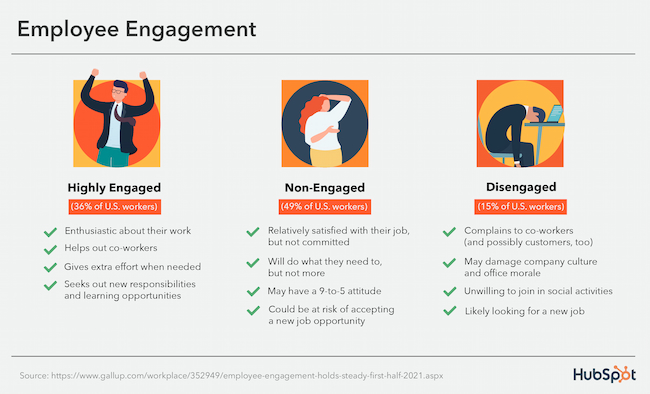
Employee Engagement Examples
Employee engagement isn’t a switch that gets turned on or off. It exists on a spectrum from highly engaged, to non-engaged, to actively disengaged. Most employees will fall somewhere in between, and their level of engagement can change over time.
Here are some examples of how engagement can show up. For each example, we’ll also highlight a stat showing how many employees fall within that engagement group, as per the Gallup study we noted in the introduction:
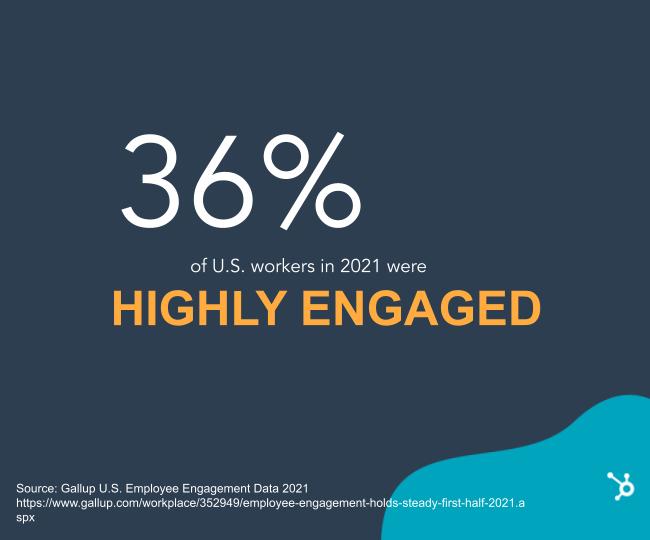
Highly Engaged [36% of U.S. workers in 2021]
- Enthusiastic about their work
- Helps out co-workers
- Gives extra effort when needed
- Seeks out new responsibilities and learning opportunities
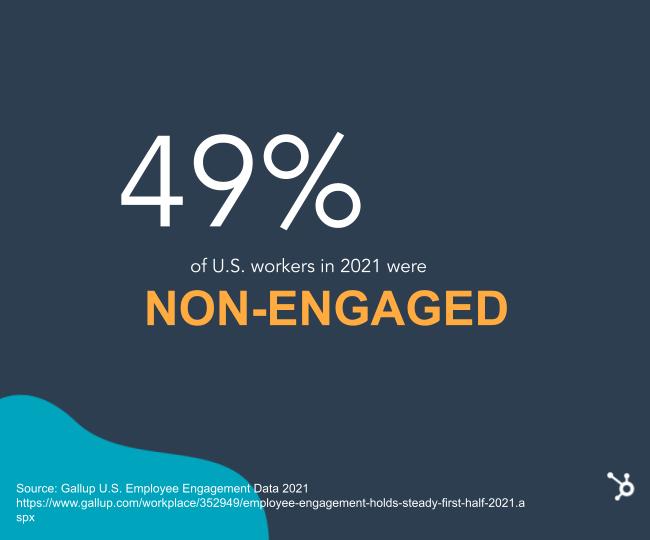
Non-Engaged [49% of U.S. workers in 2021]
- Relatively satisfied with their job, but not committed
- Will do what they need to, but not more
- May have a 9-to-5 attitude
- Could be at risk of accepting a new job opportunity
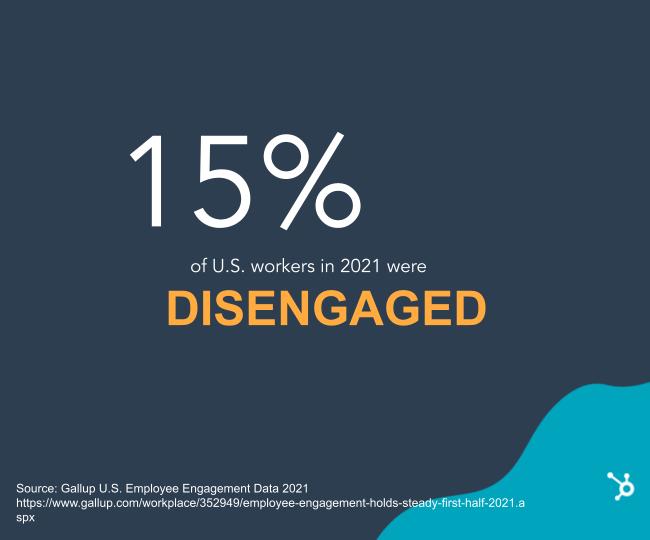
Disengaged [15% of U.S. workers in 2021]
- Complains to co-workers (and possibly customers, too)
- May damage company culture and office morale
- Unwilling to join in social activities
- Likely looking for a new job
It may be tempting to think of these behaviors as personality traits, but they may say more about your company culture instead. Even star employees can become disengaged if they don’t have clear expectations and the resources to do their job well.
Why does employee engagement matter?
Studies show that employee engagement leads to an increase in productivity, profitability, and customer satisfaction. Engaged employees are happier, healthier, and more likely to stay in their job. High levels of employee engagement have also been linked to lower absenteeism and fewer workplace accidents.
Why is employee engagement important?
“You can have the best services and best team, but if you don’t have engaged and enthused employees it won’t matter,” says Maryanne McWhirter, Sr. Inbound Marketing and Sales Consultant for LeadG2.
There’s no aspect of your business that isn’t affected by employee engagement. Your employees are the engine that makes your business function. And when those employees feel invested and respected, that engine performs at its best.
“The experience an employee has at your company soon translates to employee sentiment, which drives company culture over time. Company culture impacts your employer and consumer brand in a big way, so if we want happy, engaged customers who stay loyal, we have to implement that same strategy with our employees first.” ~ Leanne Poirier, Manager of Internal Communications at ZoomInfo
That’s why decades of data from Gallup show the following benefits of employee engagement:
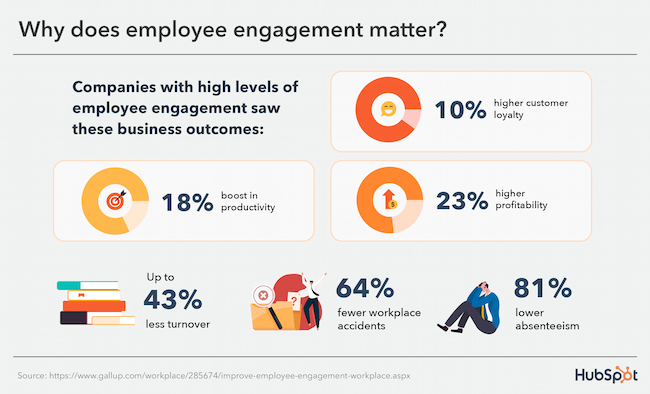
1. 10% Higher Customer Loyalty
From sales to service, highly-engaged employees deliver a great customer experience.
Again, Kayla from Seismic tells us “When we do [employee engagement] well, we can attract, develop, and retain the best talent, which means our customers are more likely to be well-served.”
2. 23% Higher Profitability
It makes sense that higher customer loyalty would lead to increased sales and reduced service costs. But highly-engaged employees also reduce costs associated with turnover, absenteeism, and injury.
3. 18% Boost in Productivity
When employees feel connected to their work, they work harder. They’re also more likely to go above and beyond their daily tasks. Engaged employees are more likely to suggest new ideas and innovate new processes.
4. Up to 43% Less Turnover
Highly-engaged employees feel recognized and rewarded. They understand their growth potential and see development opportunities ahead.
On the flip side, the Gallup study also shows that 74% of disengaged employees were actively looking for new employment.
5. 64% Fewer Workplace Accidents
It’s easy to get complacent about routine tasks, which can lead to carelessness. But when employees are engaged they focus on the work they’re doing. They’re also more aware of their surroundings, and more likely to follow safety rules.
6. 81% Lower Absenteeism
Whether because of increased drive or decreased burnout, engaged employees are more likely to show up.
This doesn’t mean normal sick-days or personal time. Absenteeism refers to habitual and intentional unscheduled absences. The kind that, according to the Society for Human Resource Management (SHRM), reduces productivity by 36.6% as co-workers take on added work.
How to Measure Employee Engagement
Measuring employee engagement can be difficult because it’s a subjective experience. To get a full picture, you need to pay attention to both the quantitative and qualitative signs.
- Seek ongoing feedback. Individual conversations are one of the most powerful ways to discover engagement levels. Ask if your employees feel valued. If they understand their growth potential. If they have the resources they need to do their job.
- Watch your rates of absenteeism and turnover. Spikes in these metrics are common symptoms of low engagement, and a sure sign something has gone wrong.
- Do exit interviews/stay interviews. Exit interviews can be a good source of candid and honest feedback. Just be sure these interviews aren’t the first time you’re asking these kinds of questions.
How to Improve Employee Engagement
Employee engagement should be thought of as an ongoing process, like developing your company culture. Engagement isn’t about ping-pong tables and casual Fridays. There are no quick fixes, so think about the full picture instead.
Marchetti of Seismic, tells us, “Our goal is to create an environment that supports and encourages our people to do their best work every day.”
With that in mind, here are some strategies to consider for improving employee engagement:
1. Start with a plan.
Poirier from Zoominfo suggests, “Taking the time to ask questions like ‘Who is our typical employee? What does their work-life balance look like? What challenges do they face? What do they need and what do they want?’ We know good marketing strategies lead to increased revenue; employee experience works the same way. When companies treat their employees with the same thought and care they do with customers, everybody wins.”
2. Communicate clear expectations.
Engaged employees understand their tasks, responsibilities, and goals. More than that, they understand how those things fit into the wider company goals. That understanding can only come from leadership.
This means holding goal-setting meetings, performance reviews, one-on-ones, and regular, ongoing feedback.
3. Provide the knowledge and tools they need to do their job.
This may seem like common sense to some, but many times employees are only given enough information or resources to do the next task. Sharing knowledge and access empowers employees to contribute beyond their to-do list.
4. Give them trust and autonomy.
Trust and autonomy go hand-in-hand. When employees feel trusted enough to work autonomously, they feel like their skills and contributions are valued. This fosters a sense of responsibility and satisfaction toward their work.
5. Offer ongoing training and development opportunities.
Developing new skills encourages employees to think of their role in terms of a career. Investing in new skill training encourages them to think of that career within your organization.
Workplace training programs help to engage and retain employees. This can take the form of an education stipend, internal training programs, peer-to-peer training, lunch-and-learns, and more.
6. Provide a clear growth path.
Having a roadmap for career growth helps create a sense of purpose at work. Managers should have regular discussions about career goals and development with their employees.
This is especially true for younger generations. A study published in the Journal of Leadership in Organizations found that 91% of Millennials valued discussion about career progression as early as during recruitment.
7. Be transparent about compensation.
According to PayScale’s survey of over 500,000 employees, pay fairness and transparency were more important than market value.
Put another way: believing their pay was determined fairly had a greater impact on employee engagement than being paid more.
8. Start employee recognition programs.
Everyone wants to be recognized when they do good work. Whether it’s a few kind words or a small perk, public recognition can go a long way toward boosting engagement.
Design a program that highlights behaviors that align with your company values. This not only encourages those behaviors but helps to show that your values aren’t just a slogan.
Pro Tip: Rewards can be difficult to coordinate with remote employees. Third-party vendors make it easier to distribute incentives. We like personalized swag from companies like Reachdesk that give a human touch to your gifting. Or virtual gift cards from services like Rybbon, because cash is always a welcome bonus.
9. Start peer recognition programs.
Peer recognition programs are a great way to create a sense of community and collaboration. They also help to celebrate successes that may otherwise go unseen by management.
One lightweight solution is to make an outlet for public kudos. Matthew Stibbe, CEO of Articulate Marketing suggests, “Set up a ‘validation channel’ in Slack or Teams and encourage your colleagues to use it to recognise great work across the business. Peer and manager recognition can be very motivating.”
You can also give your employees the power of perks. At HubSpot, each employee has a quarterly opportunity to nominate a teammate that’s helped them in some way. The nominated employee gets a monetary bonus and the knowledge that their help was valued.
10. Create social outlets.
62% of employees with one to five work friends would reject an outside offer, according to SHRM’s Workforce study. Creating a sense of community and belonging is a powerful driver of engagement.
It’s even more important for remote employees who may not have daily positive interactions with co-workers.
“In the remote world we’re living in, a great way to create the employee experience is through building a virtual community and destination for the employee base. Company intranets are often outdated and overlooked, but when given the right resources, they’re an exceptional tool for employee connection and helping your employee engagement program reach its potential,” adds Leanne Poirier from ZoomInfo.
Here are a few ideas for virtual socialization to get you started:
- Shared virtual activities. Think wine-and-design, book clubs, or even Dungeons and Dragons.
- Optional drop-in “water cooler” meetings. No talking about work allowed.
- Slack channels dedicated to shared interests. HubSpot has hundreds of Slack channels, for everything from pet pictures to true crime podcasts.
Just be sure to make these activities optional. Nothing ruins the mood like mandatory fun.
11. Seek ongoing feedback.
Communication should be a two-way street. Listening to your employees– and then acting on that feedback– makes them more likely to contribute.
Upward reviews, employee surveys, and feedback discussions should be regular features. Be receptive to, and transparent about, the feedback you receive.
Again, be sure to act on it. Few things destroy employee engagement faster than making them feel ignored.
12. Prove It.
Any company can say they live their values, but can they prove it? Outside frameworks like B corp certification or ‘Investors in People’ accreditation show where your priorities are.
Stibbe from Articulate Marketing points out, “The best people want to work in companies that reflect their own values and priorities. If you want to engage employees, you need to show them what you believe in. Words matter. Commitment is important. But in our experience, externally-audited standards such as B Corp and Investors in People are essential to set objective standards and demonstrate our progress towards them. It’s not just words. It’s proof.”
Getting Engaged.
There’s a lot to consider here, but you don’t have to do it all on day one. Choose a few strategies and commit to taking action. Be upfront with your employees about your engagement goals, and then share the progress you’re making.
Editor’s note: This post was originally published in October 2019 and has been updated for comprehensiveness.
[ad_2]
Source link


